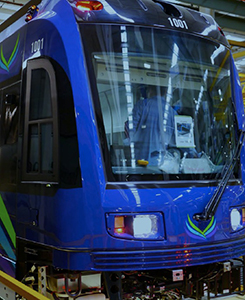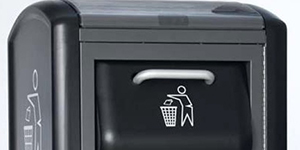CITY OF ATLANTA INNOVATION DELIVERY TEAM
Building a Greener, More Resilient City
Whether it is piloting new ways to procure efficient products, implementing cutting-edge techniques to turn waste into cost savings or accommodating our growing bike community, our departments are stepping it up in creative ways to make Atlanta a greener, more resilient city.
Reshaping Downtown with the Atlanta Streetcar
 Set to hit the streets in 2014, the Atlanta Streetcar will transform how we get around and experience Downtown Atlanta. Estimated to support 2,600 riders each weekday, the electric streetcar will provide a more sustainable and viable alternative to buses with less noise and fewer emissions. Ultimately, the Atlanta Streetcar will become part of a completely new system of local and regional public transportation. Phase One will provide an important connection between key city landmarks: the Martin Luther King Jr. memorial area, the College Football Hall of Fame and the National Center for Civil and Human Rights Museum.
Set to hit the streets in 2014, the Atlanta Streetcar will transform how we get around and experience Downtown Atlanta. Estimated to support 2,600 riders each weekday, the electric streetcar will provide a more sustainable and viable alternative to buses with less noise and fewer emissions. Ultimately, the Atlanta Streetcar will become part of a completely new system of local and regional public transportation. Phase One will provide an important connection between key city landmarks: the Martin Luther King Jr. memorial area, the College Football Hall of Fame and the National Center for Civil and Human Rights Museum.
Mayor Kasim Reed wants to double the number of commuters taking bikes to work. The City is working hard to meet this goal by building out 26 high priority bicycle projects.
Cycle Atlanta
In 2013, the City of Atlanta finished the first two of 26 new projects that will enhance bicycle safety and increase access for cyclists. To ensure that city bike plans reflect the needs of the growing cycling community, the Department of Planning and Community Development forged a partnership with Georgia Tech to develop the crowd-sourcing app Cycle Atlanta. Cycle Atlanta tracks where cyclists travel to give the City an idea of where, when and how people are biking. It also allows the user to log spots that cause trouble—such as a row of cars parked in a bike lane—and locations with services or amenities, such as coffee shops with public bathrooms. Cities around the country have been looking to Atlanta to learn about how the city has effectively engaged the bike community to build smart transportation solutions.
RM Clayton Cogeneration Project
The R.M. Clayton Wastewater Treatment Plant, in northwest Atlanta, flared excess methane gas during operations—wasting high-energy fuel—but the Mayor’s Office of Sustainability and the Department of Watershed Management have collaborated to solve this problem.
In 2012, the plant was equipped with a combustion engine that converts waste biogas into nearly 13 million kilowatt-hours of useful energy annually. The system also captures more than 39,000 million Btu of waste heat and uses it as process energy for the anaerobic digesters.
The project converts waste energy and waste heat into electrical and heating supplements, saving upwards of $700,000 a year by providing power for the primary wastewater treatment processes. Once additional project elements are complete, plant operators expect the energy savings to exceed the current 20 percent savings mark. The success of the project has also propelled Atlanta closer to its sustainability goals by reducing its energy footprint by 3 percent this year alone.
The Airport Leads on Lighting
Hartsfield-Jackson Atlanta International Airport became the first airport to launch a head-to-head lighting manufacturer competition to evaluate, select and procure reduced energy facility lighting. Led by the Creative Innovations team at the Airport, the competition invited major lighting manufacturers from across the US to showcase their LED lighting technologies. Presented with a suite of offers, the Airport was able to identify the most energy efficient lighting strategies for its North and South Public Parking Garages.
The energy savings resulting from the new lighting system will gross well over $500,000 each year. The team is now evaluating the possibility of expanding the LED lighting program to the Passenger Terminal Complex, in addition to other airport areas.
Big Belly Solar Trash Compactors
 Keeping streets litter-free is a challenge for all big cities. The Department of Parks and Recreation launched the BigBelly™ Solar Trash compactor program to tackle this challenge head-on. Big Belly trash compactors take up no more space than a regular outdoor trash container, but by automatically compacting trash with solar power, they can hold five times the capacity of regular bins.
Keeping streets litter-free is a challenge for all big cities. The Department of Parks and Recreation launched the BigBelly™ Solar Trash compactor program to tackle this challenge head-on. Big Belly trash compactors take up no more space than a regular outdoor trash container, but by automatically compacting trash with solar power, they can hold five times the capacity of regular bins.
This year, the installation of 21 units in Piedmont Park helped the City reduce collections from an average of 17 per week to just one. Each Big Belly trash compactor operates for a week on the energy it takes to make a pot of coffee and holds up to five times the volume of ordinary trash receptacles—about 150 gallons before compaction. This, coupled with the fact that the bins operate for a year on the energy it takes to drive a trash truck one mile, means the City will substantially reduce greenhouse gases and other pollutants to our environment.
In late 2013, the Department of Parks and Recreation received a matching grant from the Kendeda fund to increase the number of waste receptacles currently in our city parks. This grant will allow the department to exchange 254 traditional bins with 220 Big Belly Solar waste and recycling units. The department hopes to start deploying the new receptacles in the first quarter of 2014.
Download full version (PDF): Atlanta Innovation Report
About the City of Atlanta Innovation Delivery Team
www.atlanta.gov
“The City of Atlanta’s Innovation Delivery Team will focus on two major issues: Improving customer service for city residents and working to reduce street homelessness.”
Tags: Atlanta, City of Atlanta Innovation Delivery Team, GA, Georgia, Mayor Kasim Reed






 RSS Feed
RSS Feed